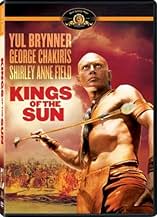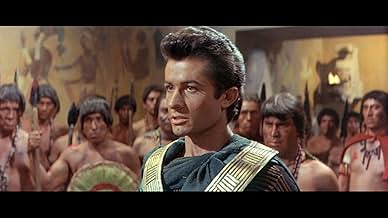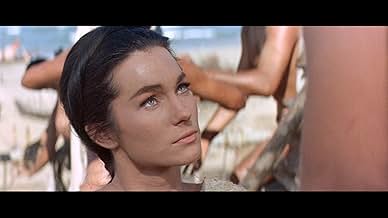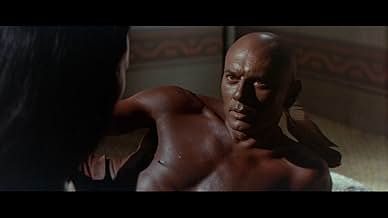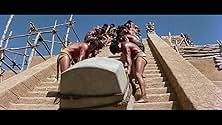CALIFICACIÓN DE IMDb
6.1/10
2.3 k
TU CALIFICACIÓN
En la costa del Golfo de México, la tribu nativa americana del jefe Águila Negra se enfrenta a la tribu maya del rey Balam.En la costa del Golfo de México, la tribu nativa americana del jefe Águila Negra se enfrenta a la tribu maya del rey Balam.En la costa del Golfo de México, la tribu nativa americana del jefe Águila Negra se enfrenta a la tribu maya del rey Balam.
- Dirección
- Guionistas
- Elenco
Victoria Vetri
- Ixzubin
- (as Victoria Vettri)
James Coburn
- Narrator
- (sin créditos)
Chuck Hayward
- Indian Warrior Friend to Black Eagle
- (sin créditos)
José Torvay
- Mayan Elder
- (sin créditos)
Opiniones destacadas
Talk about originality. This film broke new ground in its telling of culture clash in the New World many years before the arrival of the White Man. Made in 1963, the slowly changing face of race and minority relationships was just beginnng so for the first time in major motion picture history we have a "historical epic" between just the good old indians around with nary a cowboy in sight. The beginnngs of political correctness not withstanding they couldn't quite cast the movie with just Indians, maybe Jay Silverheels was under contract with some other studio, and besides they needed some Really Big Stars. Enter Yul Brenner who could outking anybody that side of Sean Connery and the rest is history. Sure the storyline is laughable by todays standards but that only makes it more fun. My main point is as follows- 1. WHERE IS THIS MOVIE? Has it decayed into dust? I have not seen this movie on television for 25 years. I cannot find it on VHS. 2. REMAKE THIS MOVIE This movie should be remade with the wandering tribe being the Egyptians who brought pyrimads and that cool game that predated basketball. The final battle would be with the Egyptians a classic East vs West battle. Bloodheart/Gladiator production values would give us the never before view of these great cultures as never before.
Writing in "Wild West Movies" Kim Newman draws attention to the lack of mainstream Hollywood product about America prior to Columbus .Indeed he identifies only two such movies -The Norseman (Lee Majors) and this one .Newman is dismissive of its merits but while no masterpiece ,and indeed it has no pretensions to being ,the movie is fun in its own cheesy way . It describes the flight of the Mayans after military defeat at the hands of their Toltec enemies,and their settlement in what is now the Southwestern USA .They form an alliance with the Apaches ,headed by Yul Byrnner and together they unite to resist the pursuing Toltecs.This is despite the conflict between Brynner and the head of the Mayans ,played by George Chakiris ,over the favours of the Apache princess played by Shirley Ann Field . Brynner lends his considerable presence to the role of the Apache chieftain and easily overshadows Chakiris in the acting stakes ,while Field is ridiculously miscast .Some attempt is made to give the characters modern resonance by having Chakiris make a stand against human sacrifice but neither characterisation nor script is really the issue here This is movie dominated by action and spectacle .The battle scenes are well staged and the sets are magnificent with some striking location photography ,shot in Chicen Itza ,Mazatlan and Yucatan ,being a definite bonus Low marks for intellect but its fun movie making and while cheesy its also enjoyable
One major advance films have made since the "classic era" of the 1960s and before that, is in realism of characters. You don't see white people playing Asians or blacks or Indians anymore. When you do see it, in these old films, it now looks ludicrous and takes away from the seriousness of the movie.
Yul Brynner, however, is one guy who could get away with it. Here, he plays Mexican-Indian warrior "Chief Black Eagle" and he's believable. Whether it's his deep, menacing voice or bald head with striking feature, Yul was cool no matter role he played.
I can't say the same for the rest of the cast. The co-star, George Chakaris as "Balam (the ninth)" as the same pretty-boy hairstyle right out of the late '50s/early '60s; Richard Basehart ("Ah Min," a Mayan priest) has coloring on his face and wig you have to see to believe! Barry Morse ("Ah Zok") will forever be typecast as "Lt. Girard" the man who harassed for years TV's "The Fugitive." Meanwhile, there is film-TV-tough guy Leo Gordon as "Hunac Kell" and Shirley Anne Field as "Ixchel." Field is beautiful and looks the part, but a British accent in Mayan territory? However, as the film goes on, Field is more and more believable, for some reason.
Whatever, there's always the story and a nice widescreen print now out on DVD, which I was fortunate enough to obtain for rent. It was filmed in the Yucatan, so the scenery is real - not some studio back lot.
In the story, Balam's Mayans get pushed out of their area by a war-mongering neighbor, led by Kell. There is nowhere to escape except by water over the Gulf of Mexico. This was no easy feat back in these early days. They make it, start to build their new homes and civilization, only to run into the Indians who already reside nearby. They are led by Chief Black Eagle and he's not too friendly.
The rest of the film answers two big question: 1 - What will happen between the two groups? Will one annihilate the other, or can they live in peace? 2 - What if the old enemies - Hunac Kell's barbarians - show up? And......of course, the big question: who gets the girl?
Yul Brynner, however, is one guy who could get away with it. Here, he plays Mexican-Indian warrior "Chief Black Eagle" and he's believable. Whether it's his deep, menacing voice or bald head with striking feature, Yul was cool no matter role he played.
I can't say the same for the rest of the cast. The co-star, George Chakaris as "Balam (the ninth)" as the same pretty-boy hairstyle right out of the late '50s/early '60s; Richard Basehart ("Ah Min," a Mayan priest) has coloring on his face and wig you have to see to believe! Barry Morse ("Ah Zok") will forever be typecast as "Lt. Girard" the man who harassed for years TV's "The Fugitive." Meanwhile, there is film-TV-tough guy Leo Gordon as "Hunac Kell" and Shirley Anne Field as "Ixchel." Field is beautiful and looks the part, but a British accent in Mayan territory? However, as the film goes on, Field is more and more believable, for some reason.
Whatever, there's always the story and a nice widescreen print now out on DVD, which I was fortunate enough to obtain for rent. It was filmed in the Yucatan, so the scenery is real - not some studio back lot.
In the story, Balam's Mayans get pushed out of their area by a war-mongering neighbor, led by Kell. There is nowhere to escape except by water over the Gulf of Mexico. This was no easy feat back in these early days. They make it, start to build their new homes and civilization, only to run into the Indians who already reside nearby. They are led by Chief Black Eagle and he's not too friendly.
The rest of the film answers two big question: 1 - What will happen between the two groups? Will one annihilate the other, or can they live in peace? 2 - What if the old enemies - Hunac Kell's barbarians - show up? And......of course, the big question: who gets the girl?
"Kings of the Sun" is a highly fictionalized story about the Mayan civilization of central America. The story has one of the last remaining Mayan groups fleeing to save their civilization. The Mayans were spread across much of modern day southern Mexico into other Central American countries. Others of their groups had been attacked and wiped out or conquered by an invading warring nation. We see clearly the distinction between the advanced civilization of the Mayans and the barbaric nature of their attackers. The movie doesn't give us a date or time frame, so it might have been any time in the latter Mayan period (100 to 700 A.D.). This was all well in advance of European discovery.
Many viewers today may not find this movie very interesting or entertaining. It is slow, for sure. There was considerable interest in ancient civilizations around the mid-20th century. And, a host of movies like this were made back then. Today we know more about the ancients, and Western interests for the most part seem to have shifted to the stars, space and the distant future. The fiction of the story here is only slightly interesting. The script isn't that good. Yul Bryner is probably the only good acting job, as Black Eagle. The rest of the cast are just so-so.
This movie has a number of conflicts with history. One has the invaders with iron weapons against the Mayans' wooden swords. In fact, there is little evidence of metal discoveries and development in the Americas. Only toward the middle of the second millennium is there some scant appearance of bronze objects. But, iron and steel appear only with the Europeans in the 16th century. That struck me as a strange thing that would belie history as well. If the Mayans were so advanced, and an agricultural society, why had they not discovered bronze or iron with which to make plows and other farming implements and tools? They hadn't yet in this movie, but the barbaric invaders had iron swords.
I note some of the reviews and correction comments that take issue with the Indian dress and tepees of Yul Bryner's tribe. But, I don't see or recall anything in the film that says the Mayans landed near the Mississippi Delta. The only evidence of any stream is a very small one. And, the vegetation that we see – trees and underbrush don't resemble anything like the moss-covered forests of Louisiana and the Bayou country. That area is very moist with considerable rainfall. But, this film has the Mayans reaching land in a dry area. So, I suggest that they would have landed in southeast Texas. They might have landed anywhere from present-day Corpus Christi to north of Galveston. That would have put them close to the lower range of the Comanche Indians. The Comanche where a fierce warring and hunting tribe that ranged across the Plains from southern Nebraska to central Texas. And, they built and slept in tepees. If one looks at a map of Gulf of Mexico, it's clear to see that the Mayans could have left the Yucatan Peninsula and sailed "across the sea," landing in southeast Texas.
At one point in the film, Black Eagle says that his people can learn much from the Mayans, and that the Mayans can learn from them. The Mayans are not hunters but farmers. We see them build a dam on a creek to divert the water to irrigate their crops. Archaeologists decades ago found irrigation ditches that had been used by the Hopi Indians of Arizona nearly 2,000 years ago. Then, in 2009 near Tucson, scientists discovered more ancient irrigation canals. Those had been used by ancestors of the Hopi in 1,200 B.C.
Many viewers today may not find this movie very interesting or entertaining. It is slow, for sure. There was considerable interest in ancient civilizations around the mid-20th century. And, a host of movies like this were made back then. Today we know more about the ancients, and Western interests for the most part seem to have shifted to the stars, space and the distant future. The fiction of the story here is only slightly interesting. The script isn't that good. Yul Bryner is probably the only good acting job, as Black Eagle. The rest of the cast are just so-so.
This movie has a number of conflicts with history. One has the invaders with iron weapons against the Mayans' wooden swords. In fact, there is little evidence of metal discoveries and development in the Americas. Only toward the middle of the second millennium is there some scant appearance of bronze objects. But, iron and steel appear only with the Europeans in the 16th century. That struck me as a strange thing that would belie history as well. If the Mayans were so advanced, and an agricultural society, why had they not discovered bronze or iron with which to make plows and other farming implements and tools? They hadn't yet in this movie, but the barbaric invaders had iron swords.
I note some of the reviews and correction comments that take issue with the Indian dress and tepees of Yul Bryner's tribe. But, I don't see or recall anything in the film that says the Mayans landed near the Mississippi Delta. The only evidence of any stream is a very small one. And, the vegetation that we see – trees and underbrush don't resemble anything like the moss-covered forests of Louisiana and the Bayou country. That area is very moist with considerable rainfall. But, this film has the Mayans reaching land in a dry area. So, I suggest that they would have landed in southeast Texas. They might have landed anywhere from present-day Corpus Christi to north of Galveston. That would have put them close to the lower range of the Comanche Indians. The Comanche where a fierce warring and hunting tribe that ranged across the Plains from southern Nebraska to central Texas. And, they built and slept in tepees. If one looks at a map of Gulf of Mexico, it's clear to see that the Mayans could have left the Yucatan Peninsula and sailed "across the sea," landing in southeast Texas.
At one point in the film, Black Eagle says that his people can learn much from the Mayans, and that the Mayans can learn from them. The Mayans are not hunters but farmers. We see them build a dam on a creek to divert the water to irrigate their crops. Archaeologists decades ago found irrigation ditches that had been used by the Hopi Indians of Arizona nearly 2,000 years ago. Then, in 2009 near Tucson, scientists discovered more ancient irrigation canals. Those had been used by ancestors of the Hopi in 1,200 B.C.
In 1963 there was a number of Hollywood fantasies based on historical and cultural themes that made the conoscenti cringe. I mean, Mayans migrating to the Gulf Coast, other Mayans using iron artifacts, arriving in the new world and speaking the same language as the locals? Well, back in those Hollywood days in the middle sixties, audiences were not quite so demanding as now. So, George Chakiris, fresh from his West Side Story triumph and Yul Brynner, known now from a number of hits, are pitched against each other in a sixty's version of a martial arts film. Veteran character actors like Barry Morse (Gerard of The Fugitive), Brad Dexter, Richard Basehart and Ford Rainey are seen sprinkled among the good guys and classic Villain, Leo Gordon heads the bad guys. The beautiful Shirley Anne Field offers the feminine interest in a departure from her roles in grade B movies and adds to the pageantry of the film. And, the usual cast of hundreds provides some nice texture and action to off-balance Brynner's hamming it up in the close-ups. This is a fine old film that doesn't have legs that was entertaining in its time. It is available but be warned: this film would be definitely grade B fare today.
¿Sabías que…?
- TriviaSome key scenes were actually filmed at the pyramid at Chichen Itza.
- ErroresThe Mayan Tribe has relocated to the Mississippi delta area yet the tribal dress of the local Indians is of the upper plains (Cheyenne and Sioux) or lower Mohawk Valley (Algonquin) tribes. The locals also use teepees rather than the log huts traditional to the lower delta area.
- Citas
Chief Black Eagle: Being rooted like trees never was meant for us. I take my people to where we belong. For there is no roof but the sky. For there are no walls to the edges of the earth. I take them to where birds sing for us. And where we live free like the deer.
- ConexionesFeatured in Best in Action: 1963 (2019)
Selecciones populares
Inicia sesión para calificar y agrega a la lista de videos para obtener recomendaciones personalizadas
- How long is Kings of the Sun?Con tecnología de Alexa
Detalles
Taquilla
- Presupuesto
- USD 4,000,000 (estimado)
- Tiempo de ejecución1 hora 48 minutos
- Relación de aspecto
- 2.35 : 1
Contribuir a esta página
Sugiere una edición o agrega el contenido que falta

Principales brechas de datos
By what name was Los reyes del sol (1963) officially released in India in English?
Responda


